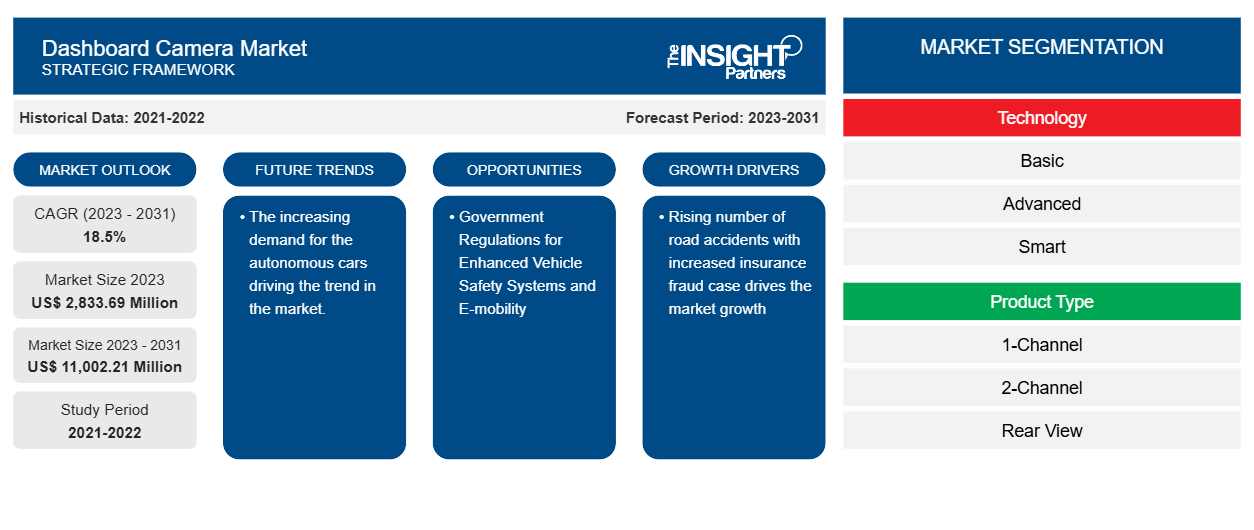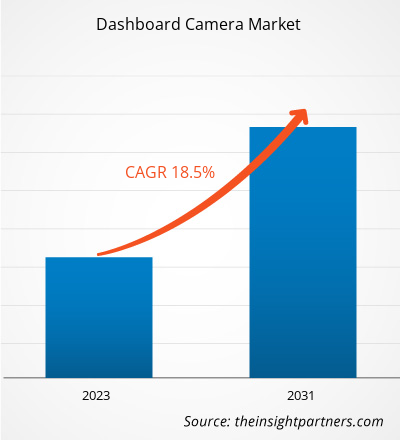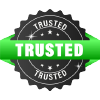The dashboard camera market size is projected to reach US$ 11,002.21 million by 2031 from US$ 2,833.69 million in 2023. The market is expected to register a CAGR of 18.5% during 2023–2031. The increasing demand for the autonomous cars driving the trend in the market.
Dashboard Camera Market Analysis
The rising frequency of automobile thefts and road accidents globally has driven up product demand over the last few years. Dashboard cams can also help avoid insurance fraud, such as deliberately causing vehicle damage to avail false insurance claims. Regulatory reforms supporting the installation of dashcams in cars for security and safety measures in numerous countries, including the US, the UK, and Russia, have also helped generate revenue. For example, dashcams are legal to own and use in the US, as their installation does not impede or break any laws. Several prominent automotive accessories providers integrate the Advanced Driver Assistance System (ADAS) system with the dashcam. For example, Harman International offers the HARMAN smart/auto VISION, a connected automotive ADAS dashcam that incorporates on-board cameras, including the front and driver-facing views. Dashboard camera enables remote vehicle surveillance features that support voice control, contextual alerts, driver distraction and drowsiness warnings, lane departure and collision warnings, and pedestrian detection.
Dashboard Camera Market Overview
Many dashboard cameras or dashcams face forward and point outward from behind the windshield for the video to match the driver's view. Several dashboard cameras record driver action by facing backward and aiming at the vehicle's inside. Dashcams for fleets are frequently linked to fleet management software, giving organizations real-time access to recordings of driver conduct incidents, such as risky or distracted driving. Dashboard cameras benefits businesses by reducing accidents, increasing the chances of fewer insurance premiums, boosting driver retention, reducing fuel cost and impact on the environment, decreasing ownership costs through lower repair fees and maintenance, and providing incident protection. The dashboard camera market ecosystem comprises the following stakeholders – hardware/component providers, dashboard camera manufacturers, system integrators and end users. Major players occupy significant places in the various nodes of the dashboard camera market ecosystem. The hardware/component providers supply the electrical components that are rated for required temperatures, accelerometers, motion sensors, camera sensor, strong adhesive, processor, and GPS among others. OEMs in the global dashboard camera market carry out various processes such as designing, assembling, and transformation of raw materials into finished products. System integrators bring the component subsystems together ensuring that they operate efficiently.
Customize This Report To Suit Your Requirement
You will get customization on any report - free of charge - including parts of this report, or country-level analysis, Excel Data pack, as well as avail great offers and discounts for start-ups & universities
Dashboard Camera Market: Strategic Insights

-
Get Top Key Market Trends of this report.This FREE sample will include data analysis, ranging from market trends to estimates and forecasts.
Dashboard Camera Market Drivers and Opportunities
Rising number of road accidents with increased insurance fraud case drives the market growth
Rising number of road accidents, car thefts, and insurance fraud have increased the demand for the global dashboard camera market. Moreover, favourable government and insurance company policies to offer discounts to cars equipped with dashboard cameras is anticipated to present significant opportunities for the companies planning to enter this market. The count of road accidents has been increasing since the past decade with the rising number of vehicles on city and highway roads. According to a report by the World Health Organization (WHO), every year, ~1.3 million people lose their lives due to traffic accidents. Non-fatal injuries impact ~20‒50 million people annually, resulting in disability and consequent loss of income. Individuals, families, and national economies incur significant economic losses due to road traffic injuries
Government Regulations for Enhanced Vehicle Safety Systems and E-mobility
High-tech dashboard cameras available in the market use computer vision and artificial intelligence to evaluate video records, giving them a better understanding of driver activities, such as cell phone use, eating, and weariness while driving. In August 2021, KeepTruckin, a market leader in fleet management technology, launched a new AI Dashcam powered by a sophisticated AI processor and intelligent computer vision algorithms for instant detection of unsafe driving with unrivaled accuracy and alert drivers in real-time. An advanced safety platform supports dashcams, leading to transformation in fleet management and enhanced driver safety. Similarly, the Nextbase 522GW high-tech dashboard camera integrates an intelligent parking mode for automatic recording if any bumps or movements are detected on the vehicle. The device also includes a 3-inch HD IPS display with Alexa-integrated playback, easy sharing, and menu selection.
Dashboard Camera Market Report Segmentation Analysis
Key segments that contributed to the derivation of the dashboard camera market analysis are technology, product type, video quality, application, and geography.
- Based on technology, the market is divided into basic, advanced, and smart. Among these, basic technology is expected to have largest share in 2023, this is owing to increased adoption in the passenger cars.
- Depending upon the product type, the market is divided into 1-channel, 2-channel, and rear view. Rear view is further segmented into Front and Rear View.
- Based on video quality, the market is divided into SD and HD, and Full HD and 4K. Among these, SD and HD have largest share in 2023, owing to increased demand across the globe for passenger cars and commercial vehicles production.
- Depending upon, the application, the market is divided into commercial vehicle and personal vehicles. Among these, personal vehicles have a largest share in 2023, owing increased adoption among the consumers in their vehicles.
Dashboard Camera Market Share Analysis by Geography
The geographic scope of the Dashboard Camera market report is mainly divided into five regions: North America, Asia Pacific, Europe, Middle East & Africa, and South & Central America.
Asia Pacific has largest share in the dashboard camera market owing to increased sale of EVs in this region. Rise in consumer demand for expensive features in automobiles is encouraging manufacturers to invest in high-end technological solutions. The car industry was the first economic victim of COVID-19 in China with the shutdown of major automotive production sites and manufacturing plants. The automotive market in Asia Pacific region continued to rebound strongly in 2021. Industry experts expect the automakers' margins to improve in FY22. The market rebound is encouraging the growth of dashboard camera solutions. In most countries, subsidies are a critical tool for maintaining the EV policy due to higher vehicle costs. The Japanese government arranged for US $77.1 million of EV subsidies in January 2021 to boost BEV sales. A number of new venture firms are emerging in the electric vehicle market in China, Japan and South Korea which is estimated to provide lucrative growth opportunities for the dashboard camera market.
Dashboard Camera Market Regional Insights
The regional trends and factors influencing the Dashboard Camera Market throughout the forecast period have been thoroughly explained by the analysts at The Insight Partners. This section also discusses Dashboard Camera Market segments and geography across North America, Europe, Asia Pacific, Middle East and Africa, and South and Central America.
Dashboard Camera Market Report Scope
| Report Attribute | Details |
|---|---|
| Market size in 2023 | US$ 2,833.69 Million |
| Market Size by 2031 | US$ 11,002.21 Million |
| Global CAGR (2023 - 2031) | 18.5% |
| Historical Data | 2021-2022 |
| Forecast period | 2023-2031 |
| Segments Covered |
By Technology
|
| Regions and Countries Covered |
North America
|
| Market leaders and key company profiles |
|
Dashboard Camera Market Players Density: Understanding Its Impact on Business Dynamics
The Dashboard Camera Market is growing rapidly, driven by increasing end-user demand due to factors such as evolving consumer preferences, technological advancements, and greater awareness of the product's benefits. As demand rises, businesses are expanding their offerings, innovating to meet consumer needs, and capitalizing on emerging trends, which further fuels market growth.

- Get the Dashboard Camera Market top key players overview
Dashboard Camera Market News and Recent Developments
The dashboard camera market is evaluated by gathering qualitative and quantitative data post primary and secondary research, which includes important corporate publications, association data, and databases. A few of the developments in the Dashboard Camera Market are listed below:
- Delphi announces the launch of its new range of BEV brake pads dedicated to the specific needs of BEV applications. Based on detailed comparisons, this range is amongst the most comprehensive in the world today covering the most popular models in the independent aftermarket. Vehicles include the Nissan Leaf and Tesla Model S/Model 3, in addition to the newest models such as BMW i4/iX, Mercedes EQC/EQEE/QS, and Porsche Taycan/Cross Turismo. Introducing 52-part numbers covering 2.7M Vehicles in Operation in Europe, Delphi is providing a substantial service opportunity for workshops. (Source: Company Website, February 2024)
- Allied Nippon launched EV+, an all-new, fully featured brake pad range for Electric Vehicles. (Source: Press Release, June 2023)
Dashboard Camera Market Report Coverage and Deliverables
The “Dashboard Camera Market Size and Forecast (2021–2031)” report provides a detailed analysis of the market covering below areas:
- Dashboard camera market size and forecast at global, regional, and country levels for all the key market segments covered under the scope
- Dashboard camera market trends as well as market dynamics such as drivers, restraints, and key opportunities
- Detailed PEST and SWOT analysis
- Dashboard camera market analysis covering key market trends, global and regional framework, major players, regulations, and recent market developments
- Industry landscape and competition analysis covering market concentration, heat map analysis, prominent players, and recent developments for the dashboard camera market
- Detailed company profiles
Frequently Asked Questions
Which region dominated the dashboard camera market in 2023?
What are the driving factors impacting the dashboard camera market?
What are the future trends of the dashboard camera market?
Which are the leading players operating in the dashboard camera market?
What would be the estimated value of the dashboard camera market by 2031?
What is the expected CAGR of the dashboard camera market?
- Historical Analysis (2 Years), Base Year, Forecast (7 Years) with CAGR
- PEST and SWOT Analysis
- Market Size Value / Volume - Global, Regional, Country
- Industry and Competitive Landscape
- Excel Dataset
Recent Reports
Related Reports
Testimonials
Reason to Buy
- Informed Decision-Making
- Understanding Market Dynamics
- Competitive Analysis
- Identifying Emerging Markets
- Customer Insights
- Market Forecasts
- Risk Mitigation
- Boosting Operational Efficiency
- Strategic Planning
- Investment Justification
- Tracking Industry Innovations
- Aligning with Regulatory Trends





















 Get Free Sample For
Get Free Sample For